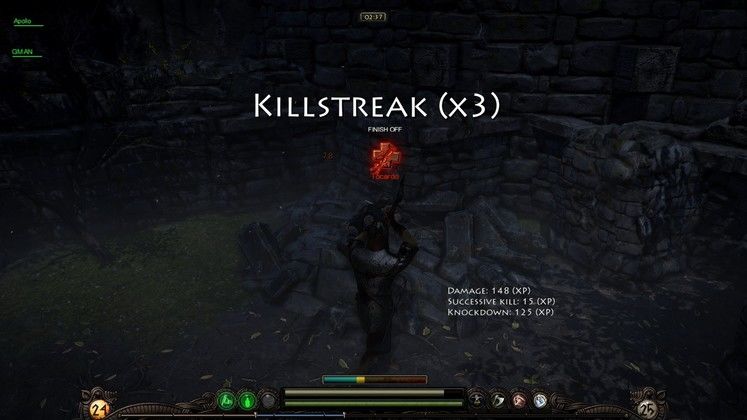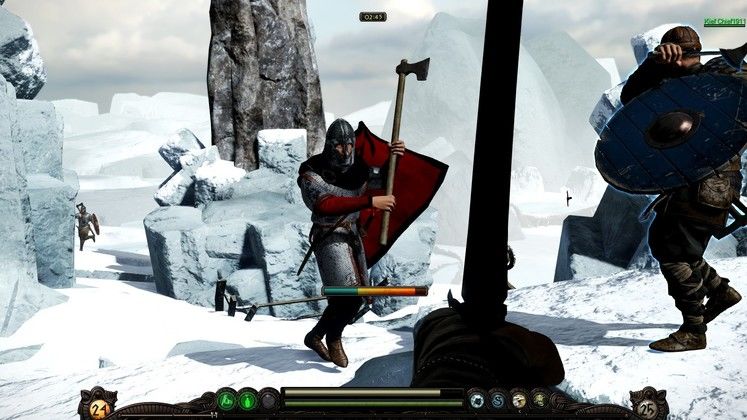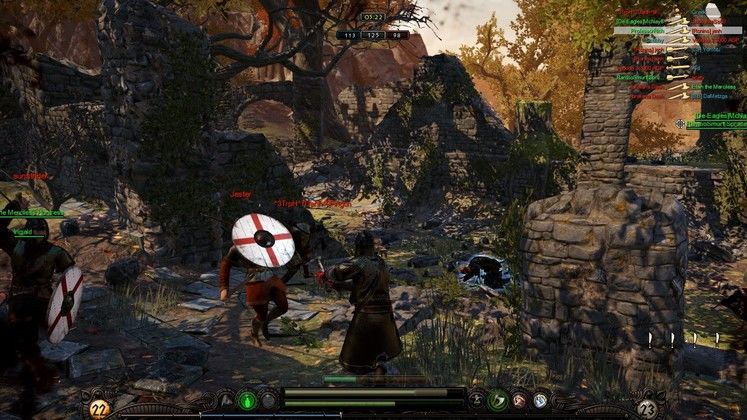Individual combat features a number of different mechanics. There are four different ways to attack with axes and swords – an overhead slash, forehand and backhand swings, and a special parry-breaking deadly attack with an elongated and risky animation. The first three of these attacks can be blocked by using the appropriate parry motion. Weapon swings have to be charged up in order to do maximum damage, but, by doing this, players telegraph their direction of attack thereby making blocking them easier. Weapon swings held for too long rapidly decrease in damage potential, preventing players from running around the map with pre-charged weapon swings as has happened in anterior melee combat games.
 |
| Downed opponents must be executed, otherwise they can be revived by team mates |
With one-handed weapons, shields may be used. These tend to make blocking easier, but can be countered with close up swings around the sides. Players can also dodge attacks. Those are like a quick dash in one of eight directions which can then be followed up with a quick swing attack if the appropriate perk, called agile fighter, is chosen. Since this greatly expands your options for attacking and fundamentally alters how fights happen, the said perk should arguably be an intrinsic ability and this is a concern which has been voiced rather loudly by the players.
Another key part of the game is that when players are critically damaged, unless they are completely smashed to bits, they will fall to the floor in a vulnerable state of casualty. Fellow team members then have the ability to help them back up with full health if they can get to them before an opponent manages to apply the coup de grâce. This makes up a very important consideration in small skirmishes. The decision to finish off or leave a foe, in particular with respect to the situation in your immediate environment, can often prove vital or fatal. Fighting against greater numbers puts you at a massive disadvantage.
There are three primary classes in the game – the skirmisher, a lightweight fighter who normally uses a bow; the warrior, a medium weight class who defaults with a sword and shield; and the champion, a heavily armoured fighter who can't use bows and is normally seen with two-handed axes. The main way that these classes can be customised is by using different perks. Each class comes with one or two locked perks and the others, to make up four in total, can be chosen. These are certainly not equal in usefulness. Some of them, for example the aforementioned agile fighter, give players incredibly useful options and are arguably obligatory. Others, such as one which allows players to backstab with a dagger and walk silently, are basically useless in comparison.
 |
| If someone with a double-handed axe is this close to your archer, you're probably in trouble |
Classes can also be customised in terms of the weapons which they start each battle with, weapons, of course, can be picked up on the battlefield, but such a thing tends to happen infrequently. The different types of weapons available are one-handed swords, one-handed axes, shields, two-handed axes, spears, bows, and a variety of throwing weapons such as knives, throwing axes, and javelins. Although I've listed all of those options in plural, the different individual items available for each type are actually nothing more than aesthetic differences such as different models and colour palettes. This means that the variety of weapons available in the game is actually quite limited, and unfortunately contributes to a feeling that the game is somewhat repetitive due to having the same kind of one-to-one encounters over and over again. On top of that, no exact statistics, such as speed and damage, are given for each weapon, which is clearly less than ideal.
Several different game modes are available, each requiring a different strategic approach. Arena mode features the smallest type of battle, and once you are dead you have to wait for the round to finish. With a maximum of four versus four, only the smallest maps are used. Skirmishes are normally well balanced, and players with a high level of individual skill are often instrumental. Pitched battle mode is exactly the same except features a higher number of players and larger battles, frequently becoming more chaotic. There is also a team deathmatch mode which can feature up to 64 players, and which allows players to rejoin the battlefield seconds after they've had their heads cut off. As you may expect, this mode is mainly about thundering around in large herds and hurling your weapons around wildly while individual skill disintegrates into the zerg-like swarm. Finally there is a conquest mode which is basically the same as team deathmatch but overall victory is determined by which team can capture and control the greatest number of zones.
There are definitely a handful of complaints I have with the game. For one, we are absolutely left wanting by the game's weapon variety. For two, the game could almost certainly benefit from a small number of design changes. For example, a huge number of online players seem to really enjoy one-to-one duels to such an extent that servers are setup as 'dueling servers'. However, the whole thing is entirely based on honour and relies on players cooperating with the imaginary dueling rules. As you may imagine, since we're dealing with the Internet then in practice that doesn't work very well. It seems completely obvious that one of the available game modes should be a dueling arena mode, but it hasn't been included. There are also numerous other minor design decisions and missing features which leave you wondering why things are the way they are. For instance, why is such a key sparring mechanic like the dodge and attack move not an intrinsic character ability? Or, why can't we see the stats for each weapon?
 |
| Team deathmatch gets messy, as always |
There is no doubt that War of the Vikings is a great deal of brutal fun, and in many situations is a game which rewards high levels of player skill. What's more, it's been put together solidly and what is there works well. For example, the hit detection appears to be more or less perfect and the only common bug which seems to crop up is a rare but annoying random crash which I didn't personally experience. I have had a good deal of fun with this game and I can see myself jumping into it every now and again for a little more.
WAR OF THE VIKINGS VERDICT
Nevertheless, the game clearly comes up lacking in some of the key areas I previously mentioned. From my view then, this is a game of unrealised potential; it hangs on the verge of being ‘good’ and instead rests sadly in the realms of ‘pretty decent’. Perhaps the most frustrating part of that is seeing that it seemingly wouldn’t take very much work to transform it into a much better offering and those desires are reflected in numbers on the steam and studio forums. Odin only knows why Fatshark have chosen to finalise things the way they have.
TOP GAME MOMENT
Smashing someone’s head to bits with a double-handed axe, blood exploding everywhere.




